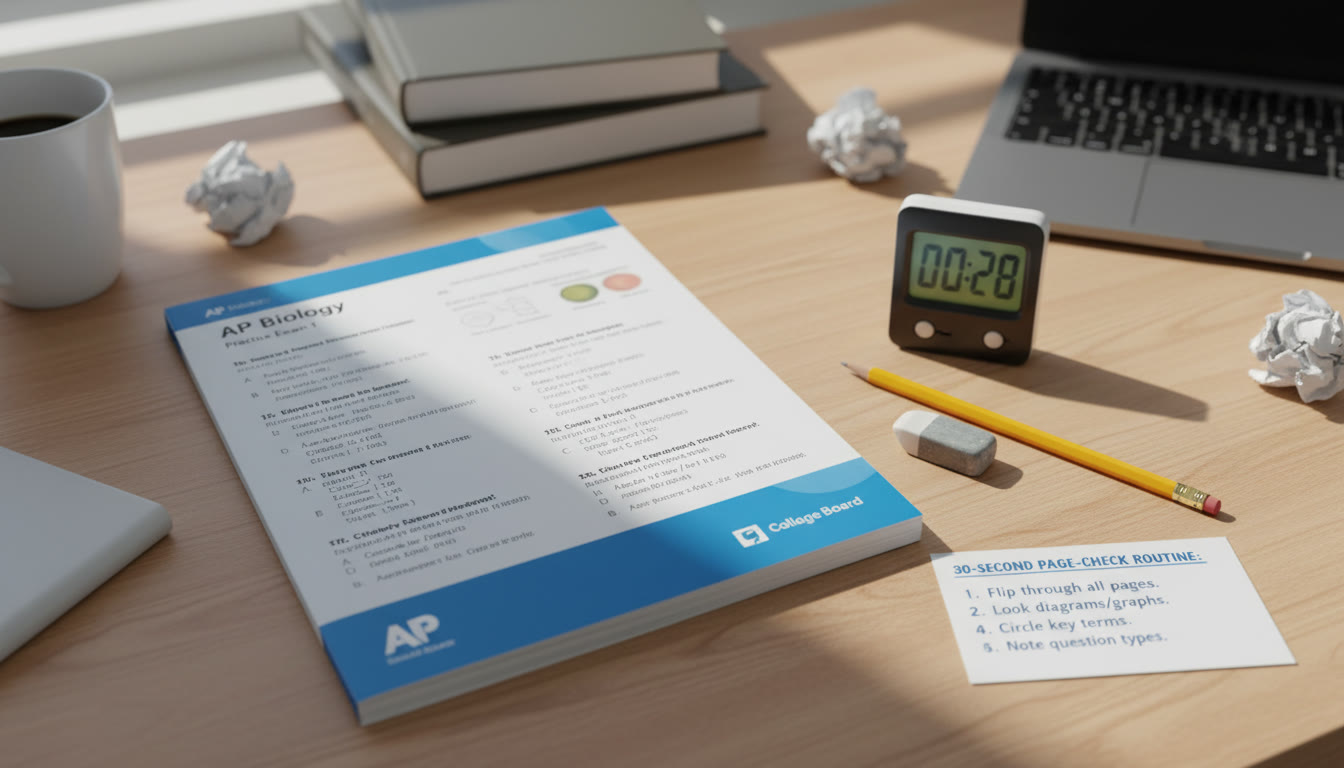Why Staples, Booklet Order, and Page Checks Matter More Than You Think
Walking into an AP exam is a lot like stepping onto a stage: you’ve prepared, rehearsed, and now you want the props to be right. For AP exams, the props are the booklets, the pages, the labels, and yes — even the humble staple. These small administrative details are rarely glamorous, but they can be the difference between a smooth experience and a stressful snag that distracts you from doing your best work.
This guide pulls together clear, practical advice on everything students should know about booklet stapling, booklet order, and page checks. Whether you’re taking a hybrid digital exam that uses a bluebook-style free-response booklet, or a traditional paper-based subject, understanding how the physical materials are organized will help you focus on the exam content instead of logistics.
Getting Oriented: Types of AP Exam Materials You’ll See
AP exams come in a few different formats depending on the subject and the year — hybrid digital models, fully digital, and traditional paper formats. The two pieces students most commonly interact with are:
- Multiple-choice/online sections — completed on a computer or testing platform for digital or hybrid exams.
- Free-response booklets — physical booklets used to write essay answers, calculations, or show work. These are the ones that get stapled and paginated.
For hybrid or paper-based free-response sections, booklets are shipped to schools, and proctors distribute them at exam time. You’ll likely encounter a cover page where you write or affix an AP ID label, followed by numbered pages for each question or task.

Staples: Small, But Protocol-Heavy
Why staples are used
Staples keep pages together, protect exam integrity, and prevent page loss during transport and scoring. They help ensure that the order of pages remains intact from the exam room to the scoring center.
Common staple locations and formats
Exam booklets may be stapled in a single corner, along the spine, or with two staples for thicker booklets. The exact placement varies by exam and booklet thickness, but proctors are trained to look for proper staple placement.
What to do if a staple is missing or loose
- Don’t try to staple the booklet yourself. The materials are controlled; altering them may create processing problems later.
- Raise your hand and tell your proctor immediately. They will follow school and College Board procedures to replace or secure the booklet in a way that maintains exam integrity.
- Document any issues politely but clearly: note the booklet code or cover information so proctors can report it properly.
Booklet Order: Pages, Sections, and Student Identification
How booklets are organized
Most free-response booklets are organized by question, with page numbers clearly printed. The front cover typically includes spaces for your name, student ID label, or a barcode label that ties your booklet to your exam session. These identifiers are critical — they ensure your written responses are matched to your score.
Why booklet order matters for scoring
Scoring machines and human scorers rely on the correct sequence of pages. If pages are missing, out of order, or separated, responses can be lost or misattributed. This is why proctors and AP coordinators emphasize careful handing and checking of materials before, during, and after the exam.
What students should check at distribution
- Confirm your booklet has the correct cover page and AP ID label (if provided).
- Quickly flip through the pages to ensure they’re in order and that no pages are loose.
- Count the number of pages if instructed to do so: some exams specify page counts on the front cover.
Page Checks: Quick Routines to Avoid Big Problems
Before you begin writing, a 30-second page check can save you from a headache later. Here’s a simple student routine that’s fast, unobtrusive, and effective.
30-Second Page-Check Routine
- Step 1: Look at the cover. Make sure your AP ID label or name line is present and correct.
- Step 2: Open the booklet and confirm the printed page numbers are sequential and no pages appear blank, stuck together, or torn.
- Step 3: Note any anomalies immediately and tell your proctor calmly.
If all looks good, tuck the booklet under your arm or place it on the desk and begin the exam. If there’s a problem, the proctor will follow the administrative steps to ensure your responses are secure and accounted for.
Examples and Scenarios
Scenario 1 — The lost page
Imagine you’ve finished an essay and reach back to check your page sequence, only to find a missing page. You tell the proctor, who first notes your concern, escorts you to a spare booklet or documents the issue per protocol, and ensures your responses are preserved for scoring. The key is prompt reporting — not improvising with your own stapling or page replacement.
Scenario 2 — A stuck page
Sometimes adjoining pages stick together due to manufacturing or ink. If this happens, alert the proctor; they’ll separate the pages following rules that prevent damage or tampering. If you try to separate pages on your own, you risk tearing, which can complicate scoring.
Scenario 3 — Incorrect AP ID label
If the AP ID label on the cover is for the wrong exam or a different student, notify the proctor immediately. They’ll correct labeling errors or reassign a properly labeled booklet. Labels and cover information are how booklets are matched to digital scores — getting this right is essential.
Table: Quick Reference — What to Do When Something’s Wrong
| Problem | First Student Action | Expected Proctor Response |
|---|---|---|
| Missing staple or loose pages | Raise hand and report immediately | Replace booklet or secure pages following protocol |
| Wrong or missing AP ID label | Point it out right away; don’t write anything | Provide correct label or swap to properly labeled booklet |
| Pages stuck together or torn | Notify proctor; don’t force separation | Proctor separates pages or issues replacement and documents incident |
| Missing pages (content missing) | Report and continue only as instructed | Document incident; provide replacement or follow up with AP Services |
What Happens After the Exam: Packaging, Chains of Custody, and Scoring
Once the exam ends, proctors gather booklets and follow strict packaging instructions. Booklets are sealed, counted, and sent to scoring centers where the chain of custody is verified. That’s why any deviation during distribution or collection needs to be reported and recorded immediately — the scoring process depends on a reliable record of where each booklet travelled.
Why student honesty and clarity help
Keeping an accurate voice when reporting problems (e.g., “My booklet is missing page 7,” rather than “I guess a page is missing”) helps proctors act quickly and creates a clean incident record. Calm, clear communication preserves your rights and avoids unnecessary confusion.
How to Practice These Routines Before Test Day
Preparation isn’t only about practice exams and content review. Add a few dry-run habits to your study schedule so that the booklet routines become second nature.
Practice checklist (repeat weekly during last month)
- Simulate distribution: place a mock booklet on your desk, locate the cover page, and pretend to apply an ID label.
- Do timed page-check drills: take 15–30 seconds to verify page order and sequence.
- Rehearse the wording for reporting issues: short, direct phrases help (e.g., “Proctor, my booklet has a loose page.”)
These micro-habits reduce the cognitive load on exam day. When something unexpected happens, you’ll act quickly and correctly without panic.
Real-World Context: Why Colleges and Scorers Care
Colleges and educational institutions trust AP scores because there’s an established, audited process behind scoring. When booklet integrity is preserved, scores reflect student work accurately. Conversely, missing or mishandled materials can delay scoring and complicate score reporting — an outcome no student wants.
How Personalized Help Can Make the Process Easier
Many students focus on content and overlook administrative fluency. Personalized tutoring can fill that gap. For example, Sparkl’s personalized tutoring offers 1-on-1 guidance and tailored study plans that include not only content mastery but also exam-day routines — from physical-material checks to timing strategies and stress management. Tutors who understand AP administration can walk you through realistic simulations so the booklet-check steps feel natural, not awkward.
What a tutor can help you practice
- Mock exam sessions that include distribution and collection cues so you know exactly what to expect.
- Time-management strategies that consider page-turning and planning space for essays.
- Calm, scripted language to report any booklet issues without delay.
Common Questions Students Ask
Should I bring my own stapler just in case?
No. Do not bring or attempt to use a personal stapler on official exam materials. Altering exam materials is not allowed and may invalidate the security and integrity of the booklet. Always notify a proctor if you suspect a problem.
Can I write on the cover or the back page?
Follow the instructions printed on the cover. Typically you can write name/ID where indicated and your answers inside the booklet only where appropriate. Extraneous marks may confuse scorers or get flagged during processing.
What if I realize after the exam that my booklet had a problem?
If you notice an issue immediately after the exam, inform the proctor before leaving. If you realize a problem later, notify your AP coordinator or AP Services as soon as possible with the incident details. Documentation and timely reporting improve the chance of a favorable resolution.
Checklist for Exam Morning: The Calm-Headed Student’s List
- Sleep and eat a steady breakfast — your brain needs fuel.
- Pack allowed supplies (pens, pencils, approved calculator, ID).
- Arrive early and locate your test room; meet the proctor if possible.
- When booklets are distributed: perform your 30-second page-check routine.
- Report any booklet or label issues immediately — don’t wait.
- Use time checkpoints during the exam to track where you should be on each question.
Final Notes: Confidence Is in the Details
AP exams reward clarity of thought and steady planning. The more you normalize the administrative steps — booklet checks, page sequence awareness, and clear communication with proctors — the more cognitive space you’ll have for writing great essays and solving problems. Think of the booklet routine as part of your performance warm-up. You wouldn’t sing without tuning, and you shouldn’t write under exam pressure without ensuring your materials are correct.
If you want help turning these routines into second nature, consider short, targeted practice sessions with a tutor who knows AP administration. Sparkl’s personalized tutoring offers focused 1-on-1 sessions and tailored study plans that include procedural practice, helping you enter exam day calm, prepared, and ready to shine.

Resources to Ask Your AP Coordinator (What to Request Before Test Day)
- Confirm the format of your exam (hybrid or fully digital) and whether a free-response booklet will be used.
- Ask about labeling procedures and whether students will apply AP ID labels.
- Request clarification about how discrepancies (e.g., missing pages) are handled.
- Ask for a brief pre-exam walkthrough of distribution and collection procedures if possible.
Wrap-Up: A Few Final Tips to Remember
- Be thorough but quick with booklet checks — 30 seconds is enough.
- Report problems immediately and clearly; the sooner the issue is logged, the easier it is to fix.
- Don’t alter exam materials yourself — always involve a proctor.
- Practice these micro-routines alongside content review so they’re automatic on test day.
- Consider personalized tutoring for procedural practice and calm exam-day simulations — Sparkl’s targeted coaching can help you combine content mastery with administrative confidence.
Preparedness isn’t just about what you know; it’s about how well you manage the details that make your knowledge count. Master the booklet basics, and you’ll remove one more distraction from the path to your best AP performance. Good luck — you’ve got this.



















No Comments
Leave a comment Cancel